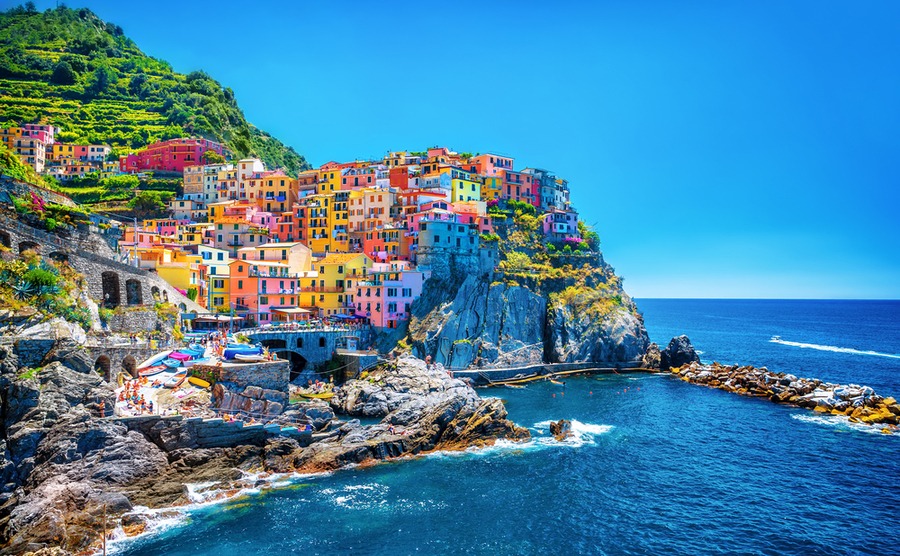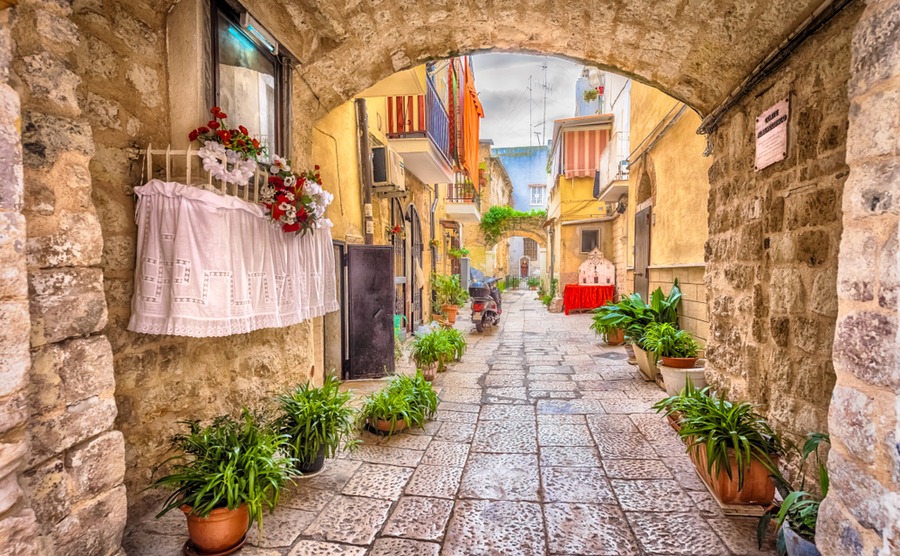A select group of non-EU countries are able to holiday in the Schengen zone for up 90 days in a period of 180 days, without a tourist visa. After Brexit, the UK was also added to the list, joining countries such as Australia, Canada and the United States of America.
90 days! That’s almost three continuous months at your holiday home in the summer, plus three months in the winter if you plan your days carefully. UK citizens have enjoyed holidays in EU countries without time restrictions for a long time, so it’s going to take some getting used to. Here we’ve tried to answer some of the most asked questions.
If you have further questions about buying property in Italy, the free Your Overseas Home webinars are a great place to find the answers. Hear from property experts, lawyers and more – all from the comfort of your sofa. Register your interest today.
What is Schengen?
Schengen refers to the EU passport-free zone that covers most of the European countries. It’s the largest free travel area in the world. When not in a pandemic, there are no border controls within the Schengen Zone. It allows people to move freely between member countries.
Which countries are Schengen members?
The Schengen Countries are Austria, Belgium, Czech Republic, Denmark, Estonia, Finland, France, Germany, Greece, Hungary, Iceland, Italy, Latvia, Lithuania, Luxembourg, Malta, Netherlands, Norway, Poland, Portugal, Slovakia, Slovenia, Spain, Sweden, Switzerland, Liechtenstein. Note that Iceland, Norway, Liechtenstein and Switzerland are on the list, but are not EU member states. Although Ireland is in the EU it has opted out of the Schengen Agreement and instead operates its own visa policy.
You could do 90 days in the summer, for example mid-June to mid-September, and then 90 days mid-December to mid-March.
Which countries don’t need a visa for short stays?
There are 63 countries who have negotiated visa-free access to the Schengen states for short stays, usually 90 days in any 180-day period (EU 2018/1806 Annex II). Included on this list are Australia, Canada, Colombia, Hong Kong, Japan, New Zealand, United Kingdom and the United States of America. For longer stays you must apply for a visa.

British citizens are able to holiday in the Schengen zone for up 90 days in a period of 180 days, without a tourist visa.
When was this introduced for British citizens?
According to the Consolate Generale d’Italia in London, “In accordance with the provisions of the EU Regulation 2019/592, starting from 1 January 2021 (the end of the Brexit transition period) the United Kingdom will be added to Annex II of the EU regulation 2018/1806. British citizens will therefore not need a Schengen Short-Stay Visa to spend up to 90 days in Italy within a period of 180 days.”
Can property owners stay longer?
Owning a property in Italy doesn’t entitle you to stay longer. You must be a registered resident or have a long stay visa.
Want a holiday home but worried about the cost? Why not pool finances and buy with family? Explore our guide, Buying Abroad with Family.
Can I break up the 90 days?
The rules allow for either a single visit of 90 consecutive days or for multiple visits in and out of the zone as long as a total of 90 days out of any 180-day period is not exceeded.
Are trips to other countries counted in the 90 days?
The 90-day limit is the same whether visiting a single Schengen Zone country or multiple countries in the zone. If you visit your holiday home in Italy for 30 days, then decide to take a trip to Malta, your days in Malta will be added onto the 30.

Owning a property in Italy does not entitle you to stay longer than 90 days
How does the “rolling” 180 days work?
The 180 days is a “rolling” period, meaning the days are counted backward from the day you leave the Schengen zone. In other words, the day you fly home from Italy, you should be able to count back 180 days and be certain that in that period you have been in the Schengen zone for less than 90 days.
What’s the easiest way to plan my 90 days?
The best way to plan your trips is to use the “Schengen calculator” on the Schengen visa info website. Keep in mind that the date of entry is considered as the first day of stay and the date of exit is considered as the last day of stay. You can type in the dates you would like to travel, and it will calculate how many of the 90 days you have left.
The Schengen calculator is useful for planning your whole year’s travel as you can type in various future dates to help you decide the best way to arrange them over the year. It’s also possible to download similar free apps to your phone, to help you keep track of your travels.
We can put you in touch with a trusted lawyer for advice about purchasing property.
How does it work over a year?
You could do 90 days in the summer, for example: mid-June to mid-September. Then 90 days mid-December to mid-March. What you can’t do is put six months together.
As a trial using the Schengen calculator, I typed in 90 days I thought were a good time to visit a second home in Italy over 180 days of spring/summer. Selecting 15 – 29 April for site seeing and enjoying the spring flowers, 1 June – 15 July for the great summer temperatures and then 1 – 30 September for end of the summer sun. Even then, it still leaves months available for a winter break.
During the hottest 6 weeks of the summer from mid-July to the end of August, many holiday home owners prefer to avoid the heat and earn some money renting their property out at good rates for six weeks. Spring and early summer is a wonderful time of year in Italy as the weather is good, but not too hot. The beaches and popular resort towns are also quieter than in the summer. This makes it the perfect time to visit your holiday home.
What travel documents and entry requirements are there?
A non-EU national has to present a valid passport at the Schengen port of entry. It must have been issued within the previous 10 years and valid for at least six months after the date you intend to leave the EU. Your passport should have two available pages for the entry stamp. If you are a national of one of the third countries and need a visa, you will also need to show your visa.
EU/Schengen border officials may also ask for other information and documents such as evidence of sufficient funds, proof of accommodation, how long you intend to stay, round-trip airline ticket, the purpose of your entry, travel insurance, invitation letter, etc.

You could do 90 days in the summer, for example mid-June to mid-September. Then 90 days mid-December to mid-March.
Will my passport be stamped?
Yes, it’s important that the border officer gives you an entry stamp in your passport when you enter the Schengen area. Without a stamp, you could be fined or detained. It acts as a “declaration of presence”. Note that, if you are travelling with someone who has a UK passport, but who became resident in Italy before the end of the Brexit transition period, their passport should not be stamped.
What will happen if I stay over 90 Days?
Those who overstay this period, whether intentionally or unintentionally, may face penalties, including deportation and a ban on entering the Schengen zone for a number of years. Information about your movements is shared around the Schengen zone, so it will be flagged up even if you have overstayed by a day. If you find yourself in an extreme circumstance that makes it impossible to return home, you should speak to the local immigration office at the police headquarters (Questera) of the Italian province you are in.
Those who overstay the 90 day period, whether intentionally or unintentionally, may face penalties
Which countries need an Italy tourist visa?
The countries whose citizens are required to obtain an Italy Tourist Visa in order to enter for short stays, include Russia, Pakistan, China, Turkey, India and Philippines. The full list is here. Travellers must apply to the Italian Embassy/Consulate or a visa application centre in their country of residence. They will be asked for a bank statement, travel Itinerary and proof of how they will be financing their trip to Italy.
If I buy a property during my visit, can I stay longer and become a resident?
This depends on your nationality. Nationals of EU / EEA member countries can stay longer, but should register with the relevant Italian authorities within 8 days of arrival.
Passport holders of visa-exempt countries must return to their home country after the 90 days and apply for an Italian National Visa. This is because visa applications must be done in person in your country of residence.
Nationals of countries that still have not signed a visa-free agreement with Italy and the other Schengen members, must obtain a visa before heading to Italy, or any other Schengen member country.
Don’t spend any money on your move abroad until you’ve read The Currency Guide to Emigration, free to download.
What happens once I get a National Visa for Italy?
Non-EU citizens in possession of a National Visa for stays longer than 90 days must request a residence permit (permesso di soggiorno) from the Italian authorities within eight days of entry into Italy. This residence permit is issued for the reason and for the period indicated on the visa, and requires a photo and fingerprints.

If you plan to spend longer than 90 days in a 180 day period, such as for retirement, you will need a long-stay visa
Do I need a long stay visa for Italy?
The Ministry of Foreign Affairs and International Cooperation – the foreign ministry of the government of the Italian Republic (also referred to as Farnesina) – have a visa checker on their website. You simply select your nationality, country of residence, length of stay, and reason for stay from drop down lists. It will immediately offer basic information on whether you need a visa, where to apply and the documents needed. As an example of what to expect see my previous article on ‘How to retire to Italy as a non-EU citizen’.
You can get further information on visa requirements from Italian Embassies and Consulates in your home country. Italy has around 123 Embassies and 83 Consulates spread all over the world, so there is likely to be one in your nearest capital city. A list of contact details for Italian Embassies or Consulates in specific foreign countries can be found on the embassy-worldwide website.
If you plan to spend longer than 90 days in a 180 day period, such as for retirement, you will need a long-stay visa
Can I apply for Italian Citizenship?
There are various situations that might enable you to apply for Italian citizenship. These include having Italian parents, being resident in Italy for 10 years, or marrying an Italian citizen. The full list can be found on the website of the Italian Ministry of Foreign Affairs.
What healthcare cover do I need?
If you’re travelling for a short stay, your European Health Insurance Card (EHIC), or the new Global Health Insurance Card (GHIC), is valid when travelling to an EU country. However, it is also recommended to get travel insurance as this offers greater cover.
Can I travel to Italy right now?
Due to the Coronavirus pandemic, visa applicants may be asked to provide proof that they are in a condition of urgent need to enter Italy. In fact, anyone entering Italy can be asked this question, and the border guards can refuse entry if not satisfied. Even if your home country and airlines are allowing you to leave for holidays or house viewings, you should always check the current situation in Italy and whether you’ll actually be allowed entry.
This is an ever-changing situation and restrictions vary depending on which country you are travelling from. For example, countries in List C of Annex 20 under an ordinance in force until 30 April 2021, must undergo a Covid test within 48 hours of travelling to Italy, isolate for 5 days, then have another negative test result at the end of the isolation period. To keep up to date with changes to travel information relating to Covid-19 visit the salute.gov.it website.
Start planning your viewing trip, ready for when travel restarts. Read the free Italian Viewing Trip Guide.













